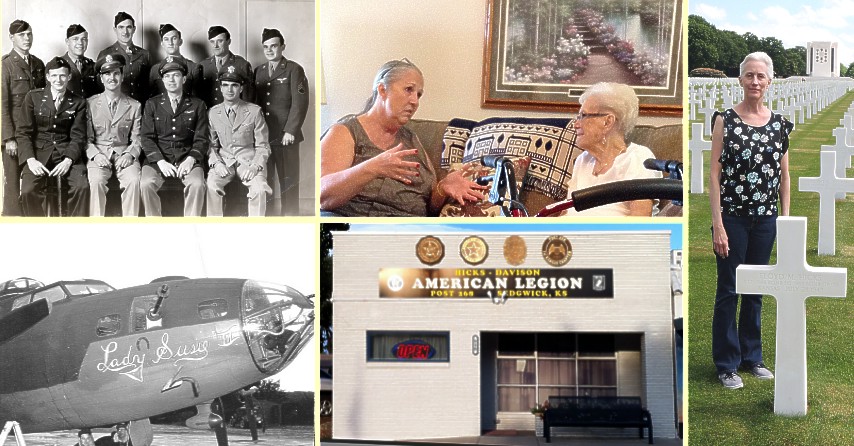Kansas Snapshots by Gloria Freeland - August 14, 2015
Finding Floyd
After reading my column last August about the "Road to Liberty" markers the French erected shortly after World War
II, high school friend Sherri emailed me.
I loved this column as it hit close to home for me. My dad's brother, Floyd, served during WWII... I actually
don't know a lot of the details about his service, except that he was in the Air Force and died a hero to my family
during a bombing mission when his plane was shot down over the North Sea.
Floyd's 385th Bomb Group was stationed at Great Ashfield, 80 miles northeast of London. His 10-man B-17 bomber crew
was typical: a pilot, co-pilot, navigator, bombardier, radio operator, flight engineer and four gunners who handled the
machine guns. Second Lt. Floyd Max Hicks was the co-pilot.
During the war, air bases like the one where Sherri's uncle was stationed were dotted across much of southeastern
England. They were separated to limit the effect of enemy attacks and to avoid congestion during take-offs and landings.
Each of these bomb groups was typically divided into four squads of 16 planes, although on any given day, only 12 were
scheduled to fly.
It was common for crews to fly the same plane mission after mission, but mechanical problems or combat damage often
required crews to fly other aircraft. Often the pilot of a new aircraft gave it a name. Crew members frequently paid an
artistic service member to paint the name and sometimes a related figure on the fuselage near the nose.
On July 28, 1943, Floyd and the others were part of a bombing mission on the Focke-Wulfe aircraft plant in
Oschersleben, about 100 miles southwest of Berlin. The principal threats to a bomber were enemy aircraft and
anti-aircraft - flak - guns. The mission progressed smoothly until they were returning to their base. The
"Lady Susie II" was hit by flak and went down over the North Sea. Five of the crew were reported killed, three were
listed as missing and two were taken prisoner. Loraine Hicks, Floyd's wife of a year and a half, was notified he was
missing.
The war ended in 1945. Floyd's status was changed from MIA - missing in action - to FOD - a finding of death.
Loraine eventually remarried.
But there was more to come. During the war, many planes crashed in enemy territory or at sea. Recovered bodies were
routinely buried locally. Floyd's story continued on the island of Sylt, a 25-mile-long strip of land 20 miles west of
the coast where Germany meets Denmark.
Floyd's grave was found in a private cemetery five years after the war was over. A 1950 Hutchinson News article
stated that Floyd's parents, Clarence and Lucy, requested that his body be buried in a permanent American cemetery in
Europe, and he was buried at the Ardennes American Cemetery near Neupr�, Belgium.
After exchanging e-mails with Sherri for some time last year, I told her I would try to visit Floyd's grave if I
were ever close enough to do so. I certainly never expected that would happen this year!
This past spring, Art began researching his Uncle Rolland Vaughan's experiences as a member of the 44th Combat
Engineers. Rollie had been involved in the Battle of the Bulge, so we planned to visit Wiltz, Houffalize, Vielsalm and
Gouvy, all towns where he had been posted during World War II. We planned to travel to those towns in June.
While the Ardennes American Cemetery was farther than these other villages from our base in Metz, France, it was
still within an hour's drive of several of them. So we visited Liege for a sidewalk caf� lunch and then drove the few
miles to the cemetery southeast of the city.
It was a quiet, warm, sun-filled day. Only a few people wandered among the gravestones. I was overwhelmed by the
sheer number of white stone markers.
We stopped first at the American Battle Monuments Commission building. It had a map accompanied by a book
containing the plot, row and grave number of every burial.
We walked to Plot C, Row 24, Grave 6. The simple white cross was like the others except for the inscription:
FLOYD M. HICKS
2 LT 548 BOMB SQ 385 BOMB GP (H)
KANSAS JULY 28, 1943
As I looked at Floyd's cross, I felt I knew him just a little. I remembered Sherri's story about how he sang to calm
himself and his crew during their bombing missions. I recalled the photo she had sent of Floyd and his unit. Floyd was
flashing a wide, beautiful smile.
Over the years that have followed, Floyd's youngest brother Vernon was the only family member able to visit his
grave. But Sherri said it is on her "bucket list."
I took several photos of the cemetery and close-ups of Floyd's marker. Art took my camera and told me to stand next
to it.
Later, I e-mailed the photo to Sherri. She replied:
I am finding it hard to express the appreciation I feel for you taking the time to visit my uncle's grave... I
will be forever grateful to you and your family for showing him this respect...
Floyd was the first Harvey County, Kansas man to lose his life in World War II. In February 1947, the American
Legion Post in Sedgwick, Kansas was renamed the Hicks-Davison post to honor him and another World War II veteran, Max
Davison. Floyd's parents donated his Purple Heart to the post for display.
After his parents' deaths, Vernon inherited the 48-star flag that had draped Floyd's coffin.
Then when he and his remaining siblings died, it passed to Sherri. She hopes to someday donate it to the American
Legion Post in Sedgwick.
But for now, she cherishes it as a keepsake of her Uncle Floyd Max Hicks.
